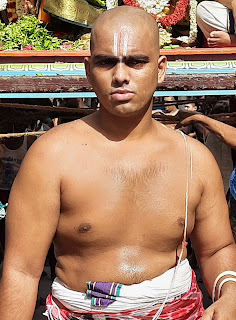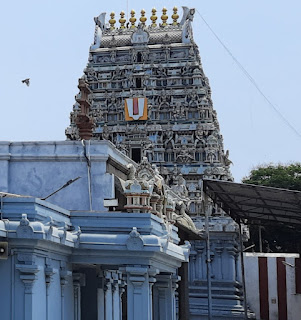While the IT boom of the 1990s and 2000s spelt death knell for many a typewriting institute with even the manufacturers shutting shop, 69 year old Mylaporean Venkatasubramanian hung on passionately and is now reaping rewards for his persistence with a strong revival in demand for Stenos
He has been running Sri Karpagam Technical Institute for close to four decades on Mundakanni Amman Koil street
When S Venkatasubramanian of Nattu Subbarayan Street completed his SSLC, he had no inkling that he would become an entrepreneur for life and a highly successful one at that creating the next generation of stenos in the city. He is touching 70 but has just found a new vigour with the surprising revival in demand for typists and shorthand specialists driven by a Government push. His business is seeing a new high with students thronging his institute on Mundakanni Amman Koil street. Here’s the story.
A Brave Enterpreneurial Venture
Venkatasubsramanian schooled at PS North. After his SSLC, he went through the then popular typewriting (lower and higher) and shorthand course while also graduating in commerce. Given the middle class background, he began his career early as a steno and worked for a few firms before joining Syndicate Bank as a steno. During this period, he also taught shorthand at a technical institute near Jammi Building in Mylapore. The students were so impressed with his teaching that they seeded the thoughts in him of starting an institute of his own. There were already a dozen institutes in Mylapore at that time and competition was stiff. However, his family was not thrilled with his entrepreneurial thoughts “I was warned that there would be no PF or Pension here as with a Government job and that such a venture was fraught with risks.”
Venkatasubramanian went against the tide and with an initial investment of Rs. 25000 (including sourced from the family) launched the typewriting and shorthand institute on Mundakanni Amman Koil street, next to PS North School in June 1984 at the age of 31. Given the location, he had to pay a high rent of Rs. 300 when he started. He also invested Rs. 10000 on setting up space in the terrace. A staunch devotee of Karpagambal, he named his venture as Sri KarpagamTechnical Institute. He set up 8 new typewriters to start with.
For someone from his generation it was a brave move to quit a job and become an entrepreneur. But he foresaw the demand and was also confident of his shorthand teaching skills. Much to his surprise, students poured in and all the 8 machines came to be filled in no time. He charged Rs. 25 per month for typewriting and Rs. 20 for shorthand.
Challenges of the IT Boom
Though there was stiff competition, there was enough business for him to sustain. A decade later, soon after the liberalization initiatives in the country, IT took off in a big way and the next generation of students did not bet on typing as a career. Co-incidentally, the next gen of institute owners too saw the same way. They would rather make their way into IT than run a typewriting institute. Many of them shut shop in Mylapore leaving his institute as one of the only three survivors of the downturn.
Despite a slowdown, he says that he never contemplated closing down the institute “I was confident that I will be able to sustain the venture and that students would return sooner than later. My wife (Jaya Gowri) has been a big inspiration encouraging me to continue to run the institute.”
His wife herself worked as a personal assistant to a Chairman of a leading firm in the city for a few decades. “We did not have children and he saw the institute as his own child. It was his passion that has led him to remain in this business for close to four decades”, Jaya Gowri, who now jointly takes care of the institute, told this writer.
Almost 40years on, Venkatasubramanian has found a new wave that is driving students back in a big way into the institute. The Government’s recruitment drive for typists and shorthand specialists has led to a revival in the institutes in the state. And his decades of experience in helping students graduate in Junior and Higher courses is getting students in large numbers at his institute.
A Revival - Surge in Demand
With the early introduction of computers in schools, the Government has lowered the qualification limit for Pre Junior course to Class VI (pass) and to the Junior and Higher courses to Class VIII and Class X. Quite unexpectedly he has seen a surge in the students at his institutes. There are currently over 150students learning at his institute that just under a decade ago moved to another location on the same street, a couple of hundred yards North of Mundakanni Koil.
The Government’s Computer Office Automation course has also generated interest among students and he currently teaches around 15 of them as per the Government prescribed syllabus including on topics such Word, Excel and Powerpoint.
When he launched in 1984, he did not visualize that at 70 he would still be continuing to run the institute but his passion to teach students and the innate ability to instantly connect with students has helped him stay the course.
He does not see the demand surge abating anytime in the near future on the back of the current drive of the Government. Interestingly, with the severe downturn after the emergence of the IT wave, typewriters seemed to be becoming a thing of the past and most manufacturers shut shop citing lack of demand. Venkatasubramanian is now banking on good quality second hand typewriters to keep his institute going. While it is coming at a high cost (seconds in English cost Rs. 8000 while the Tamil ones cost as high as 25000), the demand from students has meant that he has tripled his machines to 24.
Jaya Gowri lauds the commitment of her husband “Not once in the last three decades has he taken off from the institute. He is there every morning just before 7am and again in the evening after 3pm. He has found great joy of teaching and hence has stayed away from all other external activities including attending functions. It is his passion alone that has kept this institute going while I was away at my work for decades.”
His experience also led the industry body to choose him as the General Secretary of the TN Commerce Institute.
Just over a couple of decades ago, one had thought that typewriters would become outdated. While most of the institutes in Mylapore moved away from this business, Venkatasubramanian hung on passionately and he is now reaping the rewards for his patience.
Reversal of Trend
His has been a case of passion reaping rewards in life. It may have been tempting for him to shut shop when IT boom spelt doom to the typewriting industry but he believed in himself and was confident that even with the emergence of computers, there would be an important role for institutes such as his. He had the foresight and vision that if he hung on, good days would be back again. And that is exactly what he is seeing today - a reverse trend with young school and college students as well as IT professionals joining his institute for 3-6 months so they could get the typing speed which is helping them in their work on the computer. And the Government drive for stenos that is getting people back into institutes such as his.
For all his success, he continues to lead a simple life at Nattu Subbarayan Street with minimal requirements. His only passion in life is to create the next generation of stenos and that he has been able to achieve successfully for close to four decades with several thousands having graduated from the Karpagam Technical Institute.




































